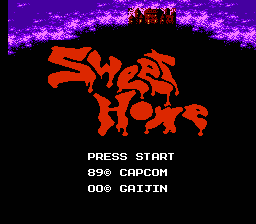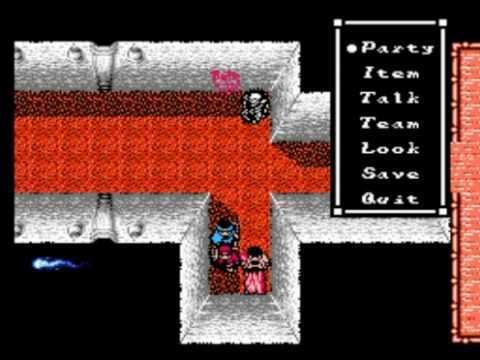Composer(s) Junko Tamiya Initial release date 15 December 1989 | Programmer(s) Masatsugu Shinohara | |
Genres Role-playing video game, Survival horror Similar Capcom games, Survival horror games, Other games | ||
Sweet Home is a 1989 survival horror role-playing video game developed and published by Capcom for the Family Computer. It is based on the Japanese horror film of the same name, and was supervised by the film's director, Kiyoshi Kurosawa. The game was released exclusively in Japan and was not localized to other regions due to its use of brutally horrific imagery. The game was directed by Tokuro Fujiwara, who later went on to produce Resident Evil. Sweet Home heavily inspired the Resident Evil series, and is regarded as a survival horror game in retrospect.
Contents
Gameplay
Sweet Home is set within a mansion that has a cohesive, intricate layout. The game has five player characters, who can go solo or be grouped together into teams of two or three. The five characters have specific skills that are necessary to complete the game, with each character having an individual unique item: team leader Kazuo's lighter, master locksmith Emi's lockpick, medic/nurse Akiko's medicine, Taro's camera, and maid Asuka's vacuum cleaner. The player can switch between characters and parties, and items can be dropped anywhere and retrieved later.

Sweet Home places an emphasis on puzzle-solving, limited item inventory management, and survival. The game requires backtracking to previous locations in order to solve puzzles later on. The mansion is interconnected, with rooms having alternate doors that can be unlocked, and can change based on the player's actions. The storytelling occurs both through cinematic cutscenes, which often employ brutal imagery, and through optional notes, secret messages and diary entries of past visitors/residents scattered across the mansion, which also provide clues for solving puzzles.

The combat consists of randomly encountered battles which the controlled character or party of characters must fight, pray or run away from. The only way to restore health is through tonics scattered across rooms in the mansion. The battles are presented in a first-person perspective. The game includes a variety of enemies, including zombies, ghosts and dolls.
The game also features quick time events where the player comes across a trap that requires a quick decision to be made, or else be killed. When a character dies, a death animation is shown, and the character remains dead permanently throughout the remainder of the game. Items that serve the same purpose as the dead character can be found near their corpse. For example, should the team nurse Akiko die, the team may find pill bottles which can be used to heal ailments. Depending on how many characters remain alive after the defeat of the final boss, there are a total of five different endings the player may receive.
Plot
The game's story expands on the film's plot. Thirty years prior to the story in 1959, famous artist Ichirō Mamiya hid several precious frescos in his huge mansion before he mysteriously disappeared. In the present day, a team of five documentary filmers seek to recover the paintings from the abandoned, dilapidated mansion. Upon entering, they are trapped inside by the ghost of an unknown woman, who threatens to kill all trespassers. The team decides to split up and find a way out, but the mansion is both in danger of collapsing and is occupied by countless monsters.
The team find a projection room, where they find a projector that displays an image of a couple and their baby burning. They discover that the ghost is that of Lady Mamiya, Ichirō's wife. It is revealed that thirty years previously, Mamiya's two-year-old son had fallen in the house's incinerator and was burnt alive, and Mamiya attempted to provide playmates for her son by killing several other children. She committed suicide shortly after and her ghost, unable to forgive herself, became trapped in the mansion. The team arrives in the main chamber and confronts Mamiya in a final battle.
Development
Sweet Home was directed by Tokuro Fujiwara, who previously directed Ghosts 'N Goblins. Sweet Home was one of his first console game projects, after having previously worked on arcade games. The director of the Sweet Home film, Kiyoshi Kurosawa, told him "not to worry if the game didn’t follow the movie exactly." For the development of Sweet Home, Fujiwara "was able to use the movie as a reference", getting "to see the movie and take a tour of the film studio, and use whatever essence" he thought would work in the game. He said he "carefully considered how to go about bringing elements from the movie to the game screen." The game's creators added horror elements to the storyline itself, mainly told through diary entries left behind fifty years before the events of the game. Regarding the game's technical limitations, Fujiwara said it "was mainly on the graphics front that my frustration had been building up" but he was "confident that horror games could become a genre in themselves", which would eventually lead to the creation of Resident Evil years later.
Reception
In 2010, UGO included Sweet Home on the list of 11 best survival horror games. In a retrospective at Kotaku, Peter Tieryas wrote: "I am still in awe of the level design and the way the designers help you discover the story rather than to just be told it. The house is, in essence, one big, convoluted and surreal level, the perfect allegory for the tragedy that is Sweet Home." Allistair Pinsof of Destructoid wrote: "It's a nearly flawless game that isn't only one of the best JRPGs of all time, it's also the best game to ever be released on the Famicom/NES." He adds that, despite it being "the prototype for survival horror, it is in many ways every bit as good as Silent Hill 2 or Resident Evil 2." He also considers Sweet Home's intricate mansion layout to be "superior to those of Resident Evil and Super Metroid." Resident Evil creator Shinji Mikami described Sweet Home as a "masterpiece", saying it "was a great success" and "very well designed". CONTINUE magazine said that, "in terms of how scary it was, Sweet Home really took the cake." According to CONTINUE, the "title was groundbreaking, and blazed a trail for future horror games."
Legacy
Sweet Home served as the main inspiration for the 1996 survival horror game Resident Evil, which originally began development in 1993 as a remake of Sweet Home. The first Resident Evil was directed by Shinji Mikami with Tokuro Fujiwara acting as producer. It was based on Sweet Home's gameplay system, adopting many elements from the game: the item inventory management and limited inventory; the mansion setting; the puzzles; the emphasis on survival; the "door" loading screen; the use of scattered notes as storytelling mechanics; multiple endings depending on how many characters survive; backtracking to previous locations in order to solve puzzles later on; the use of save rooms to store items when the player's inventory is full; the use of death animations; dual character paths; individual character items such as a lockpick or lighter; restoring health through items scattered across the mansion; the intricate layout of the mansion; story told through frescos; and brutally horrific imagery. Resident Evil was also originally intended to have a first-person perspective influenced by Sweet Home's battles, before the perspective was changed during development. Fujiwara said the "basic premise was that I’d be able to do the things that I wasn’t able to include" in Sweet Home, "mainly on the graphics front".
The game also inspired Resident Evil Zero, which adopts several further gameplay mechanics from Sweet Home, such as the player switching between characters, and a character dropping items anywhere for the other character to pick up. Sweet Home's short quick time events are considered a precursor to the quick time events in Resident Evil 4, 5 and 6. Sweet Home's mixture of survival horror gameplay and RPG battles is seen as a precursor to Parasite Eve. Sweet Home was the first game to primarily tell its story optionally through scattered notes, secret messages, and diary entries, a precursor to Resident Evil and BioShock. According to Destructoid, Sweet Home was also "the first game to fully realize the potential of a cohesive game world that connects beginning to end (even if Metroid attempted it first)." Sweet Home has several similarities to the Resident Evil 7 demo Beginning Hour, including the plot of a film crew going to an abandoned house, a paranormal female presence in the house, and a tragic tale involving a family that once lived there. The full game of Resident Evil 7 also pays homage to Sweet Home, with a similar side-story told through a VHS tape.
